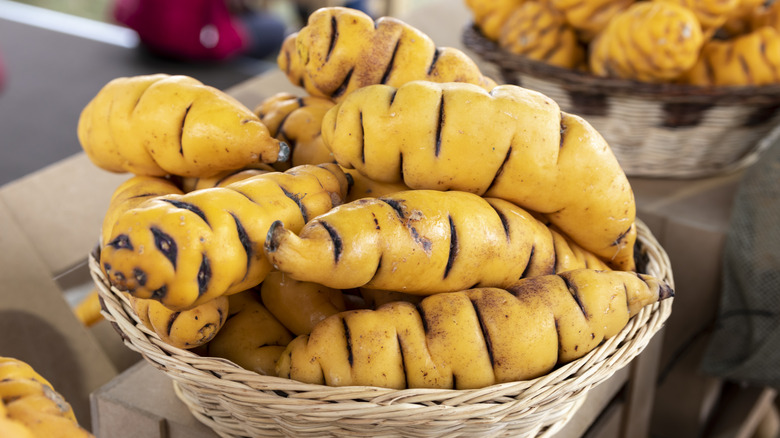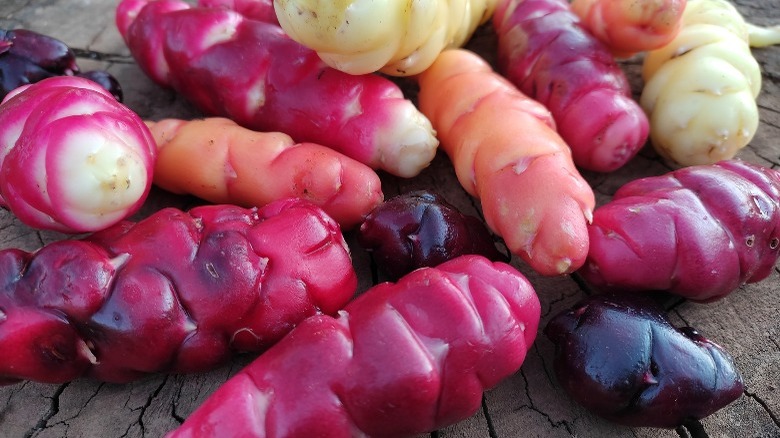The Peruvian Wine Made From Sugary Potatoes
It's difficult to imagine anything more relaxing than enjoying a glass of wine in a beautiful location. While the idea of casually sipping on a rich red may immediately make you conjure up images of a French bistro, it's not fair to pigeonhole wine to the metropolitan realm. In fact, you can enjoy a glass of wine thousands of feet above sea level (via Fine Dining Lovers).
Wine has been around for quite some time. According to National Geographic, it was early Georgians in around 6000 B.C. who discovered that grape juice, if left to ferment underground during the winter months, would transform into the alcoholic drink we know and love today.
Though wine is most often made using grapes, Winemaker Magazine explains that a plethora of other fermentable ingredients can be used as a base for your bottle of wine. You could use honey — this is called mead. You could also ferment a wide variety of fruits, as is the case in this cranberry wine. You can even make wine out of dandelions, per Hidden Legend Winery.
However, arguably the most unexpected wine base is a peculiar potato indigenous to Peru. VinePair notes that high in the Andean mountains, a man named Manuel Choqque is transforming tubers into wine.
Manuel Choqque's Peruvian potato wine
Per Fine Dining Lovers, Manuel Choqque grew up in the mountainous Andes region in Peru and is the son of potato farmers. He stuck to the family business, and has since cultivated 90 new varieties of potato since 2014. However, it's oca, a tuber of over 900 Peruvian varieties, that Choqque uses to produce his wine (via Fine Dining Lovers). It was oca's high sugar content — which, when fostered in the right condition, can produce an 11% to 12% ABV wine — that inspired him to turn it into alcohol. According to Parade, oca is sometimes referred to as "the lost crop of the Incas."
VinePair explains that Choqque's oca wine is called Miskioca, derived from the Quechuan word miski, which means "sweet." As of 2020, there were four varieties of Miskioca. There's a rosé derived from black oca. The other red wine variety is made from mashua negra, a different tuber altogether, and according to Choqque himself, it tastes so similar to Malbec that it's tricked sommeliers during blind taste tests. Yellow oca serves as the basis for the last two varieties, which are a sweet white wine and a dry white wine.
Miskioca is carefully crafted and enjoyed with Andean foods
According to VinePair, the potatoes used in the Miskioca rosé, red, and sweet white wines are fermented for eight months. The dry white's potatoes ferment for four. Fermenting potatoes to produce an alcoholic beverage is reminiscent of vodka distillation, wherein potatoes are sometimes the base ingredient. VinePair tells us that Manuel Choqque and his farmers produce 10 hectares of oca for their wine. "It is a process very similar to that of grapes — fermentation, clarification, aging, and finally bottling," Choqque told VinePair.
As Miskioca is crafted from potatoes, it cannot legally be called wine in many countries, per Fine Dining Lovers. Nevertheless, it's still enjoyed at high-end Peruvian establishments. You can taste one of Choqque's yellow oca-based white wines with a dessert course at Lima's Central. It's paired with an Andean sweet called Foresta Ambar. Additionally, if you can brave the high altitude and make your way up to Choqque's farm, the Sumaq Machu Picchu Hotel's restaurant Qunuq allows you to taste his wines alongside a three-course oca lunch (via VinePair).


